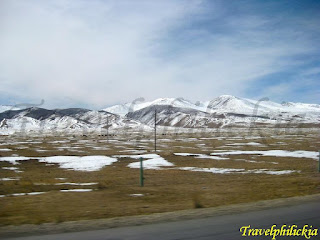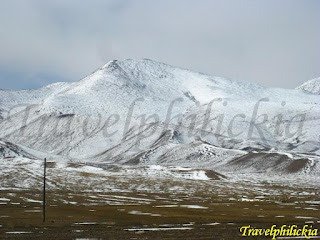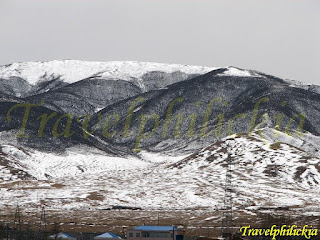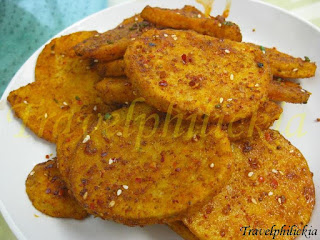Checked out from Orient Hotel Xi'an at 5 am for the morning flight to Xining. As it was very early in pre-dawn, therefore the hotel did not have time to pack our breakfast.
Wanted to have breakfast in the Xi'an Xianyang Airport transit area, but after some searching we could not find any appropriate food. Thus, we could only have our breakfast onboard the flight.
Flight to Xining
Boarded MU 2279 to Xining and flight departed on time. Stunning view could be seen during the flight (photos below).

 Opted a 'Roujiamo' (肉夹馍), or simply 'Chinese burger', for my inflight meal (photos below). Taste was acceptable but its portion was rather small for me.
Opted a 'Roujiamo' (肉夹馍), or simply 'Chinese burger', for my inflight meal (photos below). Taste was acceptable but its portion was rather small for me.

 Arrived at Xining Caojiabao Airport at about 9 am. After some introduction by Xining tour guide, we then set off our journey to Qinghai Lake.
Arrived at Xining Caojiabao Airport at about 9 am. After some introduction by Xining tour guide, we then set off our journey to Qinghai Lake.Xining (西宁)
Xining is the capital of Qinghai province (青海省) and largest city on the Tibetan Plateau. The city was a commercial hub along the Hexi Corridor of Northern Silk Road for over 2,000 years. Xining holds sites of religious significance to Muslims and Buddhists, including the Dongguan Mosque and Ta'er Monastery.
Sceneries along the Journey
Stunning sceneries of snow-capped mountains greeted us along the highway to the Qinghai Lake (photos below). We were busy taking these amazing views with our cameras.

 Riyue Mountain (日月山), or literally Sun and Moon Mountain, was spotted along this route (left photo below). The Sun (日) pavilion and Moon (月) pavilion were built on each side of the mountain in memory of Princess Wencheng of Tang Dynasty. Further down the road was the inscription of Tibetan writings on a mountain (right photo below).
Riyue Mountain (日月山), or literally Sun and Moon Mountain, was spotted along this route (left photo below). The Sun (日) pavilion and Moon (月) pavilion were built on each side of the mountain in memory of Princess Wencheng of Tang Dynasty. Further down the road was the inscription of Tibetan writings on a mountain (right photo below).

 The scenery changed to dry grassland with the snowy mountains at its backdrop (photos below). Compared to the majestic mountains in Switzerland, these snow-capped mountains brought out the solemness and demureness of nature.
The scenery changed to dry grassland with the snowy mountains at its backdrop (photos below). Compared to the majestic mountains in Switzerland, these snow-capped mountains brought out the solemness and demureness of nature.




Occasionally goats could be found grazing on the grassland (photos below).

 Lunch
LunchWe stopped at one of the restaurants "高原红川渝酒家" (left photo below) and had lunch in one of its decorative rooms facing the lake (right photo below).

 Once we walked into the restaurant, our usual request to the chief was to use less salt and oil when cooking. Six dishes were served together with rice (photos below).
Once we walked into the restaurant, our usual request to the chief was to use less salt and oil when cooking. Six dishes were served together with rice (photos below).






Qinghai Lake (青海湖)
Qinghai Lake is the largest lake within China and has a surface area of 4,317 square meters with a maximum depth of 25.5-meters. The lake lies about 100-km west of Xining city center and it took us 2.5 hours to reach from the airport.
To be exact, the place that we visited was Erlangjian Scenic Area (二郎剑景区). This scenic area is located at the south of the lake. After gotten our admission ticket from the tour guide (photo below), we then started our exploration in this scenic area.
First sculpture we saw after the carpark was the horse statue (left photo below). It depicts the "Galloping Horse Treading on a Flying Swallow" (马踏飞燕) on the logo of China Tourism. Second sculpture was the statue of Fuwa Ying Ying (福娃迎迎) which was one of the mascots for 2008 Beijing Olympics Games (right photo below).


The sculpture of Mother Queen of the West (西王母) was located next to the Fuwa Ying Ying statue (left photo below). Also known as Queen of Heaven, she is an important figure in the Kunlun legend of ancient China. A stone sculpture with engravings of 'Qinghai Lake' stands close to the lake (right photo below).

 The vastness of the lake definitely can be appreciated where its borders seemed to end at the foot of the mountains. Viewing from the south of the lake, the Datong mountains (大通山) located at the north of the lake could be distinguished (photos below).
The vastness of the lake definitely can be appreciated where its borders seemed to end at the foot of the mountains. Viewing from the south of the lake, the Datong mountains (大通山) located at the north of the lake could be distinguished (photos below).

 As it was mid-April during our visit, the ice sheets at the middle of the lake had not melted (photos below).
As it was mid-April during our visit, the ice sheets at the middle of the lake had not melted (photos below).

 In the middle of the lake stands the ruins of the Torpedo Launch Experiment Base, which is China's first torpedo testing site set up in the 1960s (left photo below). Several cruises parked neatly at the shore of the lake due to the off-peak season (right photo below), therefore no cruise ride available during our visit.
In the middle of the lake stands the ruins of the Torpedo Launch Experiment Base, which is China's first torpedo testing site set up in the 1960s (left photo below). Several cruises parked neatly at the shore of the lake due to the off-peak season (right photo below), therefore no cruise ride available during our visit.

 The lake is located at the crossroads of several bird migration routes across Asia, and many species use Qinghai as an intermediate stop during their migration (left photo below). Domestic Yak is available in this scenic area for photo-taking (right photo below).
The lake is located at the crossroads of several bird migration routes across Asia, and many species use Qinghai as an intermediate stop during their migration (left photo below). Domestic Yak is available in this scenic area for photo-taking (right photo below).

 The picturesque snow-capped Qinghai Nanshan Mountain (青海南山) located at the south of the lake could be sighted (photos below).
The picturesque snow-capped Qinghai Nanshan Mountain (青海南山) located at the south of the lake could be sighted (photos below).




The Folklore Museum (left photo below) is a free-entry museum in the Erlangjian Scenic Area. It consists of three exhibits: the picture display of Qinghai Lake, the Tibetan folklore and Wildlife display. Took a picture (right photo below) on one of its displays regarding the bird island (鸟岛) of the lake to illustrate the biodiversity of Qinghai Lake.

 We left the scenic area at about 2.30 pm. On our way to Xining, we saw some goats grazing the grasses close to the lake which they seemed to ignore passing vehicles (photos below).
We left the scenic area at about 2.30 pm. On our way to Xining, we saw some goats grazing the grasses close to the lake which they seemed to ignore passing vehicles (photos below).

 We had the last view of the beautiful Qinghai Lake from our vehicle (photos below).
We had the last view of the beautiful Qinghai Lake from our vehicle (photos below).

 Our tour guide brought us to check in our hotel for the day, Xiadu Qinghai-Tibetan Mansion.
Our tour guide brought us to check in our hotel for the day, Xiadu Qinghai-Tibetan Mansion.Dinner at Xining
After some washup at the hotel, we then proceeded to a halal-certified restaurant "悦宾楼 (城西店)" (left photo below). The restaurant occupied four levels of the building and we were ushered to one of its floors (right photo below).

 Total of six dishes were served (photos below).
Total of six dishes were served (photos below).





 Xining Traffic Vegetable Integrated Wholesale Market (西宁交通蔬菜综合批发市场)
Xining Traffic Vegetable Integrated Wholesale Market (西宁交通蔬菜综合批发市场)After dinner we visited this wholesale market. Xining Traffic Vegetable Integrated Wholesale Market is a comprehensive agricultural product wholesale market that integrates the trading and storage of agricultural products (photos below).

 Besides fruits, several dried goods were available at the market (photos below).
Besides fruits, several dried goods were available at the market (photos below).

 We were transferred back to the hotel at about 6 pm for an early rest.
We were transferred back to the hotel at about 6 pm for an early rest.Day Three
After having a fulfilling breakfast at Xiadu Qinghai-Tibetan Mansion, we then checked out from the hotel and proceeded to our first attraction of the day.
Dongguan Mosque (东关清真大寺)
Dongguan Mosque is the largest mosque in Qinghai, originally built in 1380. It has colorful white arches along the outside of the wide building and a green and white dome together with two 45-meters tall minarets (photos below).


Admission ticket that was issued to us by our tour guide (photo below) also had the massive mosque building printed on it. Behind the Dongguan Mosque Arch (left photo below) is the Prayer Hall built in Chinese traditional architecture style (right photo below). The Prayer Hall is the main building in Dongguan Mosque and covers an area of 1,136 square meters.

 It was impressive by the elaborate and elegant carvings, and the golden Islamic writings over its archway of the hall (left photo below). It is an example of architectural fusion of traditional Chinese style and Islamic features.
It was impressive by the elaborate and elegant carvings, and the golden Islamic writings over its archway of the hall (left photo below). It is an example of architectural fusion of traditional Chinese style and Islamic features.Besides, the mosque is honored as one of the four greatest mosques in northwest China. The other three mosques are the Great Mosque of Xi'an, the Xiguan Mosque of Lanzhou and the Id Kah Mosque in Kashgar, Xinjiang. Dongguan Mosque has the largest number of worshipers; about 7,000 people attend prayer activities every day, and the population rises to approximately 20,000 on Juma (a congregational prayer that Muslims hold every Friday, just after noon), and 200,000 on Islamic festivals (right photo below).


Ta'er Temple (塔尔寺)
Ta'er Temple, also known as Kumbum Monastery, is a Tibetan gompa founded in 1583 and one of the top six Gelug monasteries of Tibetan Buddhism in China.
The temple is the birthplace of the Tsong Khapa (宗喀巴), founder of Gelug school of Tibetan Buddhism (Yellow Hat Sect), and two of his disciples from this region also went on to become famous in the Tibetan Buddhist world, one becoming Dalai Lama, the other the Panchen Lama, both are great living Buddhas.
The admission ticket had an aerial view of the temple printed on it (photo below).
Tickets can be bought from the main entrance of the temple (left photo below). However, we entered the temple using a side entrance instead (right photo below).

 One of the top attractions in this temple is the Pagodas of Buddha Shakyamuni (八宝如意塔) where there are a total of eight pagodas located in the front square (left photo below). The body of pagodas is colored in white and the 5.7-square-meter base is piled up by colorful bricks. The waist of each pagoda is decorated with delicate scriptures and beautiful patterns and many standing lions (right photo below).
One of the top attractions in this temple is the Pagodas of Buddha Shakyamuni (八宝如意塔) where there are a total of eight pagodas located in the front square (left photo below). The body of pagodas is colored in white and the 5.7-square-meter base is piled up by colorful bricks. The waist of each pagoda is decorated with delicate scriptures and beautiful patterns and many standing lions (right photo below).

Another attraction is the Grand Golden Tiled Hall (大金瓦殿) that was built in 1379. It is the grandest hall with three-eave gable and hip roof palace with glazed tile walls and glided copper tile roofs (left photo below). In the niche on the top of the tower stands the 11-meters high glided statue of Tsong Khapa. This golden tower is the treasure of Ta'er Temple, and Buddhists believe that meeting the tower means meeting the master Tsong Khapa.
In front of the Grand Golden Tiled Hall stands a huge rock where pilgrims stuck dollar notes or coins onto it as part of blessings (right photo below).

 Ta'er Temple is the highest institution of Buddhism in Qinghai Province and now it has four major scholastic institutes. The Kalacha (时轮) Institute is one of them (left photo below). The other three Institutes are Xianzong (显宗), Tantric (密宗), and Yiming (医明).
Ta'er Temple is the highest institution of Buddhism in Qinghai Province and now it has four major scholastic institutes. The Kalacha (时轮) Institute is one of them (left photo below). The other three Institutes are Xianzong (显宗), Tantric (密宗), and Yiming (医明).The Main Assembly Hall (大经堂) is a place where the Buddhists gather to recite the sutras and important Buddhist activities are held (right photo below).

 We left the temple at about 11.40 am.
We left the temple at about 11.40 am.Lunch
Next, we were brought to a commercial pedestrian street (left photo below) where the restaurant was located (right photo below). Could not remember exactly the name of the restaurant.

 Total of six dishes were served in this restaurant (photos below).
Total of six dishes were served in this restaurant (photos below).





 After lunch we were transferred to Xining West station. This was where our next part of the journey starts.
After lunch we were transferred to Xining West station. This was where our next part of the journey starts.
 Posts RSS
Posts RSS





